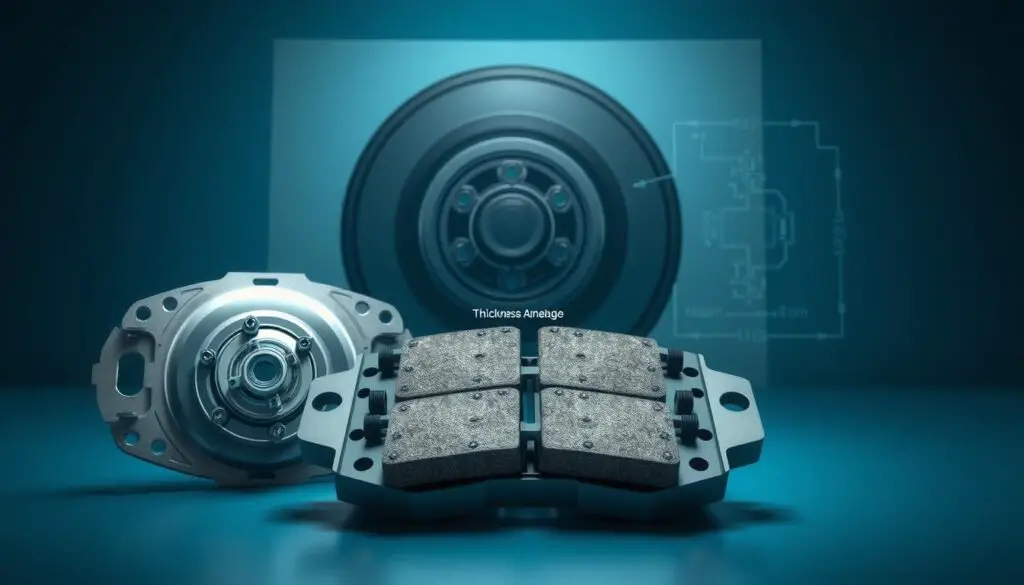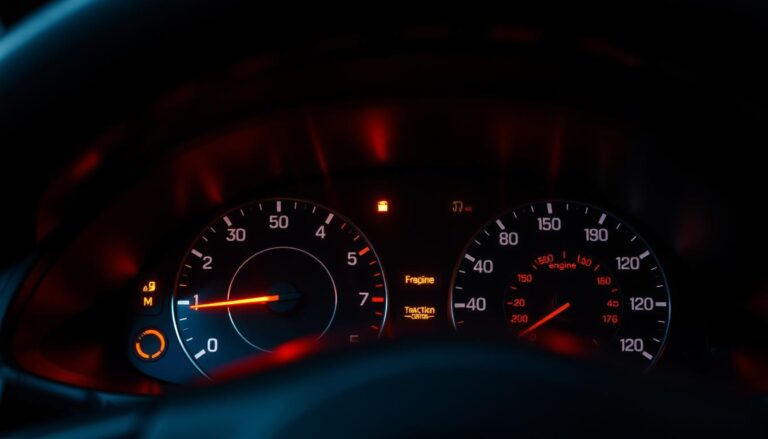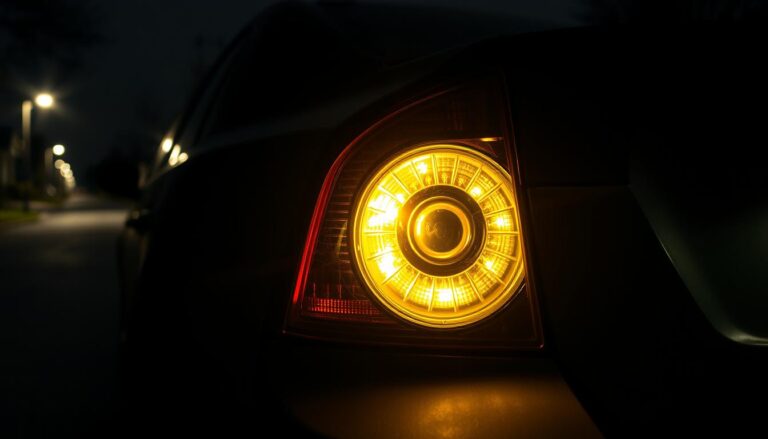This guide explains what most owners can expect to pay today for a professional pads service and why prices vary by pad type, labor, and vehicle condition.
Friction parts slow a car when calipers press them against rotors. Worn pads often trigger a dashboard warning, squeal from wear indicators, or grind loudly if metal touches the rotor.
Do not drive with compromised brakes. If you notice warning lights, noise, or vibration, tow the vehicle and get an inspection to avoid rotor damage and higher charges.
Typical lifespans range from about 30,000 to 70,000 miles depending on driving style, terrain, and pad materials. Expect per-axle totals to vary: economy, mid-range, and luxury-grade options affect both feel and long-term value.
Key Takeaways
- Per-axle pricing matters because pads are replaced in pairs for even braking and safety.
- Parts and labor both shape the final price; higher-quality pads can reduce noise and improve feel.
- Warning lights, squeals, or grinding mean service now to avoid rotor damage and higher bills.
- Pad materials range from economy to luxury; choice affects lifespan and performance.
- Professional inspections assess thickness, rotor condition, and hardware before any work begins.
Volvo Brake Pad Replacement Cost Overview
Nationwide averages give a quick snapshot of what drivers pay today for a straightforward pad swap. Most per-axle jobs land between $150 and $300, with variation from pad selection and rotor condition.
What most drivers pay today in the United States
For a 2020 XC60, standard pad sets run about $75–$120 while luxury-grade sets are $150–$250, parts only. When you add installation, a front-axle job typically totals $150–$300.
Typical price range per axle: parts and labor
- Parts: $75–$250 per set depending on type and brand.
- Labor: $80–$100 per axle at franchised centers; independent shops can be lower.
- Rotors: Scored or thin rotors add parts and labor to the bill.
When a full set makes sense versus a single axle
If both front and rear pads are near wear limits, a full set keeps pedal feel and ABS balance consistent. A single-axle service is reasonable when inspection shows the opposite axle has ample life and rotors in spec.
“Replace pads in pairs per axle to ensure balanced braking and proper ABS function.”
Key Factors That Influence Your Brake Pad Replacement Cost
Several factors combine to determine what you’ll pay when service time arrives. Knowing the main drivers helps you compare quotes and avoid surprises.

Brake pad type and material
Economy, mid-range, and luxury-grade pad options affect price, dust, noise, and rotor wear. Standard sets for a 2020 XC60 run about $75–$120, while luxury compounds cost $150–$250 for parts only.
Model-specific considerations
Vehicle weight, wheel size, and OE formulations change wear and fitment. Heavier SUVs or performance trims often need tougher compounds that raise parts and service prices.
Driving habits and conditions
Aggressive city driving, towing, or frequent mountain descents shortens life and increases lifetime spending. Check the owner’s maintenance guide for inspection intervals to catch wear early.
Labor, parts availability, and shop choice
Dealerships offer OEM access and warranty perks but often charge higher labor. Independent repair shops can be cheaper and faster for routine service.
“Get an itemized estimate for pads, hardware, and any rotor work to verify value and avoid surprises.”
- Labor time is predictable for pad-only jobs, but seized hardware or rotor replacement raises the invoice.
- Parts availability and brand choice affect scheduling and final price.
- Regular maintenance prevents metal-to-rotor contact that quickly escalates repairs.
Volvo Brake Pad Replacement Cost Estimates
A quick look at front versus rear wear and parts needs can prevent surprise bills. For a 2020 XC60, front per-axle parts typically fall between $100–$200, with labor around $80–$100 at franchised centers. That usually yields a per-axle total of $150–$300, depending on pad type and rotor condition.
Front vs. rear wear and price differences
Front pads often wear faster on many vehicles because they handle more braking force. However, system bias and driving style can make rear pads wear equally fast or faster in some setups.
Pads only vs. pads and rotors
Measure pad thickness and inspect rotors before deciding. If pads are thin but rotors remain smooth and above minimum thickness, a pad replacement alone is fine.
- When rotors add to the bill: scoring, warping, or being under spec usually means resurfacing or replacement and a noticeable jump in final costs.
- Labor impact: seized screws, corroded hardware, or stuck caliper pins increase labor costs and repair time.
- Get a written estimate that separates parts, labor costs, and any rotor work so you can compare quotes apples-to-apples.
“Timely pad replacement prevents metal backing plates from grinding into brake rotors and keeps overall expenses lower.”
Finally, ask the shop for a short road test and torque check after installation. A quick recheck confirms proper braking performance and reduces the chance of coming back for adjustments.
Warning Signs You Need New Brake Pads
Your car will usually give audible or visible signs before a serious stopping problem develops. Pay attention to sound, feel, and dashboard indicators so you can act early and avoid larger repairs.

Squealing or screeching on brake application
A persistent squeal often comes from a wear indicator built into the pads. This high-pitched sound is an early warning that you may soon need new brake components. Act quickly to prevent rotor scoring.
Grinding, vibrations, or pedal/steering pulsation
Loud grinding usually means the metal backing is contacting the rotor. That metal-on-metal contact damages rotors fast and raises the scope and price of any repair.
Vibrations or a pulsing pedal point to uneven friction surfaces or warped rotors. These symptoms call for prompt inspection to restore safe stopping.
Warning light, burning odor, and visual pad thickness checks
A dashboard light from a wear sensor is a clear sign to schedule service. A burning smell after heavy stops can mean overheated friction material or stuck hardware.
When possible, look through the wheel openings to check pad thickness. If the friction material looks thin, book a professional inspection.
- Document intermittent noises, pedal feel changes, or smells to help your technician diagnose the issue.
- Do not drive with compromised brakes; arrange towing and a prompt repair if stopping performance worsens.
| Symptom | Likely Cause | Recommended Action |
|---|---|---|
| Squeal on apply | Wear indicator nearing limit | Inspect pads; replace soon |
| Grinding noise | Metal contacting rotor | Tow if severe; replace pads and inspect rotors |
| Pedal pulsation | Warped or uneven rotors | Machine or replace rotors; verify hardware |
| Burning odor | Overheated friction or stuck caliper | Cool, inspect, and repair to prevent further damage |
“Addressing early signs limits parts damage and keeps repair costs lower.”
How Long Do Brake Pads Last and When to Schedule Service
How long your pads last hinges less on calendar miles and more on driving patterns and terrain.
Typical lifespan and what affects it
Most drivers see service needs between 30,000 and 70,000 miles. City commuting, steep grades, towing, and repeated hard stops shorten life by adding heat and wear.
Highway cruising tends to extend life, but age and corrosion still affect hardware and caliper movement over time.
Use the owner manual and maintenance schedule
Check the owner manual for inspection intervals tied to your vehicle and trim. Follow the maintenance schedule to avoid surprises and keep warranty terms intact.
- Set reminders by time or mileage to schedule service before wear indicators sound.
- Consider pad material and wheel/tire packages when budgeting long brake service intervals.
- If you notice softer pedal feel, longer stopping distances, or warning lights, you need get a quick check right away.
“Following the manufacturer’s inspection schedule yields safer stops and fewer surprises.”
What’s Included in a Professional Volvo Brake Service
A trusted shop will inspect rotors, hardware, and pad wear before recommending any work. This upfront check shapes the written estimate and helps avoid surprises.
Parts and labor: pads, rotor inspection, and hardware
Scope: technicians record pad thickness, measure rotor thickness, and note any worn hardware. The invoice should list parts and labor separately so you see exactly what’s replaced.
Replacement steps summarized: safe, thorough, and to spec
- Raise the car and remove wheels.
- Remove calipers and extract old brake pads in axle pairs.
- Inspect and measure rotors; resurface or replace as needed.
- Service hardware, lubricate slide pins, and install new pads and parts to OEM torque specs.
- Reinstall wheels, torque to spec, and perform a road test with bedding guidance.
Why it matters: clean, decontaminated brake rotors and quality parts deliver quiet stops and even friction. Any grease or fluid on rotors can contaminate pads and force extra repair work.
“Ask the shop to document pad thickness before and after, rotor readings, and part numbers for transparency.”
- Pad replacement is done per axle to keep braking balance consistent.
- Fresh hardware and correct lubrication prevent uneven wear and reduce future service.
- Request a multipoint inspection to catch related issues and control long-term repair costs.
Conclusion
Knowing when to act prevents minor friction wear from damaging rotors and raising bills.
Expect a realistic per-axle range near $150–$300, with pad type and rotor condition moving the final cost. Follow the owner manual for inspection intervals and watch time between services.
Heed warning cues—squeal, grinding, or pedal pulsation—and do not ignore any metal-on-rotor sound. If you know you need new pads soon, call a trusted repair shop that provides an itemized estimate for pad replacement, rotors, and labor.
Prompt action keeps rotors in spec, limits repair needs, and preserves confident stopping in your car.
FAQ
What do most drivers pay today in the United States for brake pad work?
Prices vary by vehicle model and region, but drivers typically see a range depending on parts quality and labor. For economy pads at an independent shop expect the lower end, while premium ceramic pads or dealer service push the price higher. Always request a written estimate that separates parts and labor.
What is a typical price range per axle for parts and labor?
A single axle job can range from budget to premium levels. The parts-only price differs from the complete service price that includes labor and small hardware. Ask the shop to list pad brand, rotor condition, and labor hours so you can compare estimates.
When does it make sense to replace pads on a full set versus just one axle?
Replace all four when front and rear wear are close in remaining life, or when rotors and calipers show uneven wear. Many technicians recommend axle-by-axle replacement if rear pads still have substantial material, but matching pad type front and rear helps balance braking performance.
How does pad type and material affect price and performance?
Material types—organic, semi-metallic, and ceramic—offer trade-offs. Organic pads are inexpensive and quieter but wear faster. Semi-metallic balance durability and braking power. Ceramic pads cost more, produce less dust, and usually last longer. Select based on driving style and budget.
Are there model-specific considerations for cars like the XC60 and similar vehicles?
Yes. Different models use specific pad shapes, shims, and sensors. Performance variants may require higher-grade pads. Parts compatibility and availability can affect both price and lead time, so provide your model year and trim when requesting quotes.
How do driving habits and road conditions affect wear and service intervals?
Frequent city driving, towing, or steep terrain increases stop-start cycles and accelerates wear. Highway driving is gentler on pads. Aggressive braking and heavy loads shorten lifespan and raise lifetime maintenance costs.
How do labor rates and shop choice change the final bill?
Dealership labor rates usually run higher than independent shops. However, dealers may use OEM parts and perform manufacturer-specific procedures. Independent shops can offer savings but verify certifications, warranty terms, and parts brands used.
What are the cost differences between front and rear pads and why do they wear differently?
Front pads typically wear faster because the front brakes handle most stopping force. That means front replacement often occurs more frequently and can cost more over time. Rear pads may last longer, depending on vehicle design and driving habits.
Do I need new rotors when replacing pads and how does that affect the total?
Rotors may be resurfaced or replaced depending on thickness, runout, and damage. New rotors add substantially to parts cost but improve braking feel and longevity. Shops should measure rotor thickness and show findings before recommending replacement.
What are the common warning signs that pads need replacing?
Listen for squealing or screeching, which often signals wear indicators. Grinding indicates metal-on-metal contact and immediate service. Feel for vibration or pulsation in the pedal or steering. A brake warning light, burning smell, or visibly thin pad material are also clear signs.
How long do pads typically last and when should I schedule service?
Lifespan commonly ranges from about 30,000 to 70,000 miles depending on pad type, driving, and conditions. Inspect pads during routine maintenance and follow the owner’s manual schedule. If you notice warning signs, schedule service promptly to avoid rotor damage.
How can I use the owner’s manual to plan maintenance?
The manual outlines recommended inspection intervals and service procedures. It also lists correct pad types and specifications. Use those guidelines when discussing parts and service with a technician to ensure compatibility and maintain warranty coverage.
What does a professional brake service typically include?
A full service generally includes removing wheels, inspecting pads, rotors, calipers, and hardware, cleaning components, measuring rotor thickness and runout, installing new pads and any required hardware, and testing the system. Labor descriptions should be itemized on the invoice.
What steps should a technician follow during pad and rotor work?
Proper service involves safe vehicle support, controlled caliper removal, pad replacement with correct orientation and shims, torqueing fasteners to spec, flushing or topping brake fluid if needed, and a safe road test. Ask shops about their procedures if you want assurance of thorough work.



